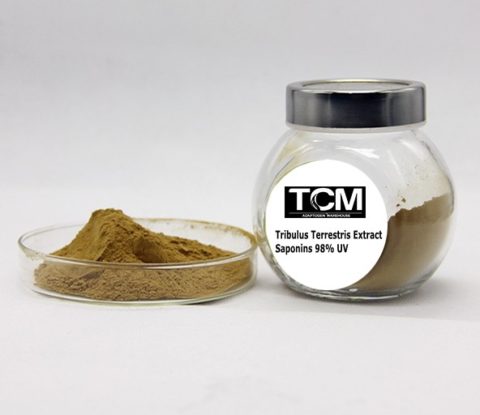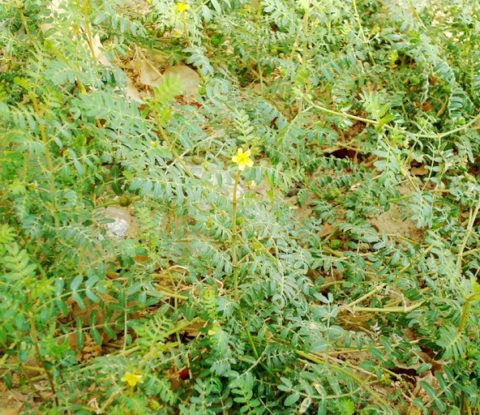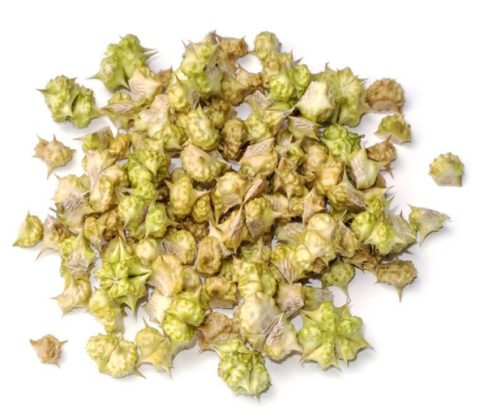
Tribulus Terrestris Extract
【Latin Name】 : Tribulus Terrestris L
【Part used】 : Fruit
【Active Ingredient】: Total Saponins& Protodioscin
【Appearance】: Brown yellow Powder
【Specification】: Saponins 50%, 90%, 95%, 98% UV; Protodioscin 20% 40% by HPLC; 10:1, 20:1TLC
【Test method】: UV&HPLC&TLC
【Mesh size】: 95% pass 80 Mesh
【Benefits】: Promote strength and immunity
Brief Introduction
Tribulus terrestris (of the family Zygophyllaceae) is an annual creeping herb widespread in China, eastern Asia, and extends into western Asia and southern Europe. The fruits of this plant have been used in Traditional Chinese Medicine for the treatment of eye trouble, edema, abdominal distention, high blood pressure, and cardiovascular diseases while in India its usage in Ayurveda was for the purpose of impotency, poor appetite, jaundice, urogenital disorders, and cardiovascular diseases. In Ayurvedic medicine, Tribulus terrestris is referred to as Gokshura or Chhota Gokshura for the treatment of lower back pain, sciatica, inflammation of the pelvic and sacral region, dry cough, respiratory disorders; it is known to be interchangeable with Pedalium murex for the purpose of gokshura.
Tribulus is a plant used in both traditional chinese medicine and ayurveda for purposes mostly related to cardiovascular health, virility, and urogenital health The tribulus genera extends to 25 species of which 12 of them are found in the middle east. There are other species in the tribulus genera that are sometimes used in supplementation, including pentandrus (has more Kaempferol in its flavonoid profile whereas terrestris has more Quercetin; pentandrus also has tricin-7-diglucoside as a unique componnet) and alatus which also possesses steroidal glycosides such as spirostane, furostane, and cholestane and is implicated in testosterone boosting similar to Pedalium murex but not tribulus terrestris.
Chemical composition
The fruits of the Tribulus plant (Tribulus terrestris fructi) contain:
-Furostanol based steroidal saponins such as terrestroside A,B as well as terrestrinin B, terrestroneoside A, and chloromaloside and glycosides of these molecules including tribufuroside C and I-J.
-Spirostane based steroidal saponins.
-Tribulusamides A-D.
-Terrestramide.
-Pregnane glycosides.
Pharmacological Benefits
1.Cardiovascular Health
1). Cardiac Tissue
Tribulus terrestis saponins (100mg/L) are able to reduce infarct size in hearts exposed to ischemia/reperfusion and oxidation in vitro, which is due to the tribulosin content (decreased infarct size to 20.24-30.32% of control with 1-100nM) in a manner that is abolished by blocking PKCε or ERK signalling at 10nM; as both the PKCε pathway and ERK signalling are involved in cardiomyocyte apoptosis, it is thought that tribulosin exerts a direct anti-apoptotic effect (specifically, by activating ERK which then translocates PKCε).
Due to activating protein kinase C epsilon (PKCε), tribulosin can protect cardiac cells from cell death. This occurs at a remarkably low concentration and is likely relevant to oral supplementation of tribulus terrestris saponins. In hypertensive humans given 3g of tribulus fruits or a water extract thereof, four weeks supplementation was sufficient to slightly reduced heart rate.
2). Blood Pressure
Tribulus terrestris appear to have ACE inhibitory properties in vitro at 0.33mg/mL 50-56% with the water extract (17-37% ethanolic and 11-28% acetone) with more potency in the aerial parts than the fruits. In rats (spontaneously hypertensive 2K1C), 10mg/kg of the lyophilized fruit extract appears to reduce blood pressure and correct the higher than normal levels of ACE.
In otherwise healthy rats, 2.5-10mg/kg tribulus terrestris appears to increase blood pressure in a dose-dependent manner (6-11%) during erections, although when the rats were not sexually stimulated there were no differences. Tribulus may reduce blood pressure via either the kidneys (a diuretic and/or protective effect) or via ACE inhibition, and while it shouldn’t influence blood pressure in otherwise normal subjects it may increase the erection-induced blood pressure spike.
In humans with hypertension, tribulus terrestris given at 2g of the whole fruit extract of a water extract thereof over four weeks noted significant reductions in systolic blood pressure (4-4.3%) by one week which increased to 9.6-10.7% after four weeks; diastolic blood pressure was reduced by 7.4-8.1% after four weeks. This study should be approached with caution as the intervention group had significantly higher blood pressure at baseline which may have exacerbated the results.
As the reduction in blood pressure was associated with an increase in urinary output, it is though that the observed benefits were secondary to the kidneys. Appears to reduce blood pressure in hypertensive humans, and while the lone study is incredibly promising more research should be put forward to ascertain the potency.
3). Platelets
Tribulus pterocarpus phenolics have been noted to inhibit platelet aggregation induced by thrombin in a concentration dependent manner between 0.5-50µg/mL (40-70%) and inhibited overall blood platelet aggregation between 3-30%. As the main bioactive for this effect was not delineated, it is unsure if this applies to tribulus terrestris.
Tribulus terrestris has been found to inhibit adrenaline-induced platelet aggregation with an IC50 value of 970µg/mL. Tribulus terrestris has weak and probably not relevant anti-platelet effects, although the species of pterocarpus appears to be quite potent. They were measured on different aggregators, however, and it is not sure if tribulus terrestris has a role in blood clotting or not.
4). Cholesterol
A reduction in total cholesterol has been noted with tribulus terrestris fruits or a water extract thereof at 3g daily over four weeks, which reached 9.49-10.23% at the end of the study (placebo down 2.14%).
2. Interactions with Hormones
1). Testosterone
A tribulus terrestris extract (Bulgarian, thus higher protodioscin) seems to be able to increase androgen receptor (AR) immunoreactivity in the rat hypothalamus (specifically, the PVN) when dosed at 5mg/kg bodyweight for 8 weeks, increasing from 162.67+/-14.73 ARs to 383.17+/-15.73 ARs (58%) suggesting it may alter androgen signalling. There was also a significant increase in neurons expressing NADPH-d by 67%, suggesting that Tribulus can increase Nitric Oxide Synthase (NOS) and subsequent NO production as NADPH-d immunostaining can be a biomarker for NOS activity. Expression of the androgen receptor may be increased in the brain, possibly related to the libido enhancing effects.
When testing for androgenic effects of Tribulus independent of serum testosterone levels, a rat study measuring prostate weight of rats subject to 11, 42, and 110mg/kg Tribulus extract (11.42% Protodioscin) with the lowest dose correlating to 750mg Tribulus extract in a 70kg human noted that, over 28 days of feeding, that aside from serum testoterone being unaffected prostatic weight was unaffected at all doses suggesting no intrinsic androgenic activity.
There does not appear to be a direct androgenic effect of tribulus supplementation (independent of increasing testosterone). When tested in vitro, an extract of tribulus terrestris did not appear to significantly inhibit the 5α-reductase enzyme.
When looking at interventions, currently those that show an increase in circulating testosterone including a non-human primate injection of isolated protodioscin (7.5mg/kg) resulting in a 52% increase acutely which returned to baseline 90-180min after injection. This same study noted that 8 weeks administration of 5-10mg/kg in rabbits and rats led to increases in dihydrot-estosterone (DHT) in rabbits (testosterone increases statistically insignificant) and in the castrated rats testosterone increased by 25% and another study exclusively using sexually sluggish rats (those that were previously shown to copulate less with receptive females) noted an increase in testosterone from 2.4+/-0.03ng/mL to 3.12+/-0.06 and 3.72+/-0.06ng/m (30% and 55% increase) with 50mg/kg and 100mg/kg fruit extract, respectively. One other study using otherwise healthy rats has noted, offhand, an increase in testosterone with both the control drug (Viagra at 0.71mg/kg) and Tribulus fruits at 100mg/kg but does not disclose total increases.
In humans, tribulus terrestris of Bulgarian origin has been shown to have no influence on total testosterone or luteinizing hormone levels when supplemented to healthy men in 200mg a day with a 60% saponin content. It does not seem to influence testosterone levels in females at 450mg (low powered case studies) and when 450mg Tribulus is adminsitered to weight trained men and rugby players for up to 5 weeks fails to note significant increases in testosterone.
It should be noted that based on body surface area conversions an oral dose of 450mg Tribulus equates to 30.94mg/kg in rat studies if we assume a 200lb human. Previous studies with dehydrate fruit extracts of Tribulus note increases in testosterone with 50-100mg/kg bodyweight in rats, which correlates to a 200lb human ingesting 727mg-1.45g Tribulus fruits.
Some human studies have shown increased testosterone associated with Tribulus supplementation, however they are confounded with coingestion of other nutrients and one which used 6g of the root extract of tribulus terrestris by itself for 60 days in infertile men noted a trend to increase testosterone (failed to be statistically significant) reaching 16.3%. This is similar to the first study using a formulation known as Tribestan where an increase in testosterone was noted in impotent male rams and suggests that the only role tribulus terrestris may have in increasing testosterone is normalizing testicular damage in impotent subjects.
When looking at animal and human evidence, there is sporadic evidence to suggest an increase in testosterone with this herb in rodents but it has repeatedly failed to increase testosterone in humans. There may be a weak increase in testosterone in infertile men, but this needs to be explored more.
2). Estrogen
A rat study using female rats and assessing intrinsic estrogenic potential of Tribulus Terrestris found no significant effect of extracts of 11, 42, and 110mg/kg bodyweight where the lowest dose correlates to a 750mg oral intake for a 70kg human.
3. Interactions with Sexuality
1). Libido
A study in fertile boars with combination therapy of tribulus terrestris, Eurycoma Longifolia Jack and Leuzea carthamoides noted that 11mg/kg oral administration (correlating to a 750mg oral dose for a 70kg human) increased mounting behaviour by 20% and increase seminal volume; higher doses (42mg/kg and 110mg/kg) were unaffective.
Various other animal models confirm aphrodisiac effects, including the lyophilized extract dried fruits at 50mg/kg and 100mg/kg in sexually sluggish male rats which noted dose-dependent increases in all parameters of sexuality and penile function increasing with prolonged administration. Intake of tribulus at lower doses of 2.5, 5, and 10mg/kg for a period of 8 weeks was associated with decreases in the latency of mounting, intromission, and ejaculation while improving mounting and intromission frequency; with 5mg/kg and 10mg/kg being of equal potency and in castrated rats Tribulus appears to be slightly less effective at 5mg/kg than were biweekly injections of testosterone cypionate at inducing aphrodisia, but both groups were lesser than an uncastrated control while another study comparing Tribulus Terrestris against Sildenafil Citrate (Viagra) in sexually normal rats at doses of 100mg/kg bodyweight and 0.71mg/kg, respectively, found that there were no significant differences between both groups, as both were more effective than control at inducing aphrodisia with similar efficacy.
In men with low sperm count, supplementation of 6g tribulus root is associated with a significantly greater improvement in sexual health (assessed by survey) by 49.38% which was greater than placebo (27.80%).
2). Erectile Properties
In the rabbit corpus cavernosum in vitro, tribulus terrestris fruit extract (lyophilized water extract) at 0.25- 4mg/mL is able to induce relaxation in precontracted tissue in a concentration dependent manner and is independent of Nitric Oxidemetabolism (not inhibited by L-NAME or methylene blue), prostaglandin metabolism (indomethacin ineffective), and independent of potassium channels (4-AP and glibenclamide ineffectve). Changes in cAMP and cGMP could also not explain the observed effects.
Elsewhere, a mixture of tribulus terrestris and cornus officinalis (the latter working via nitric oxide metabolism) has noted that tribulus alone was more effective than all mixtures of the two herbs and that the mixture was no more proerectile following oral ingestion than tribulus alone.
An increase in erectile properties have been noted in rabbits given 2.5-100mg/kg of a tribulus fruit extract for one month and this dosage range has been noted to enhance the efficacy of proerectile signalling molecules (acetylcholine or electrical stimulation) without affecting antierectile signalling molecules. Protodioscin by itself in ineffective and this same dosage range in rats appears to enhance the intracavernous pressure (ICP) of the penis by 17-43% (most efficacy at 5mg/kg) during erections.
Tribulus terrestris appears to relax penile tissue in vitro and enhances erections after oral ingestion, but the difference in dosages (quite high in vitro yet low oral doses) suggests differing mechanisms of action. The mechanism by which tribulus increases erections is not known, but may be related to central androgen receptors. In persons with low sperm count given 6g of tribulus root daily for two months (where almost half of participants reported erectile problems) there was significant improvements in the loss of erection (6.03%), rigidity (9.41%), premature ejaculation (6.12%), and lack of orgasm (9.76%).






